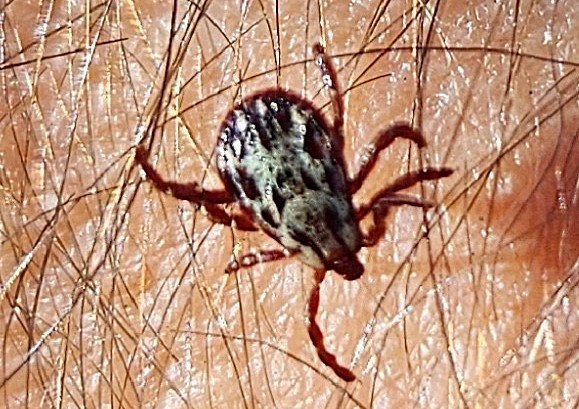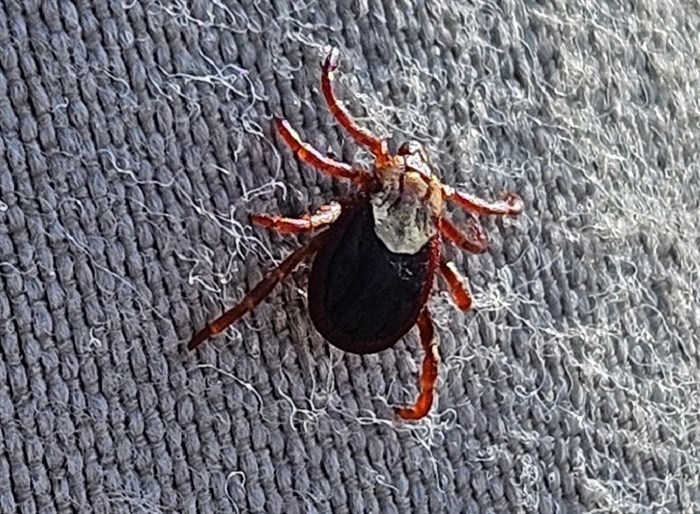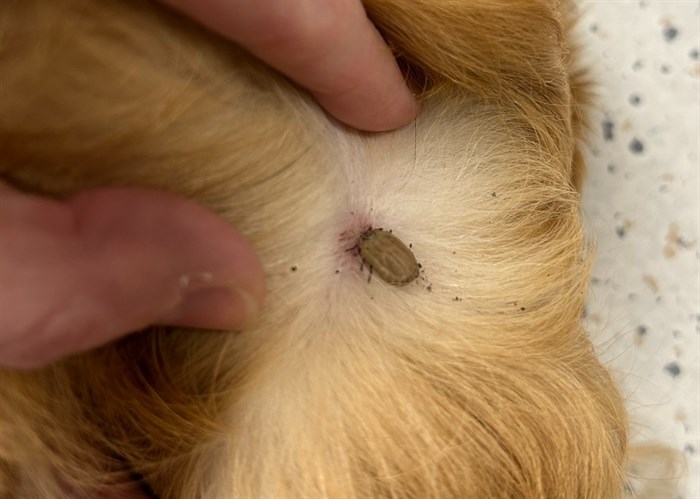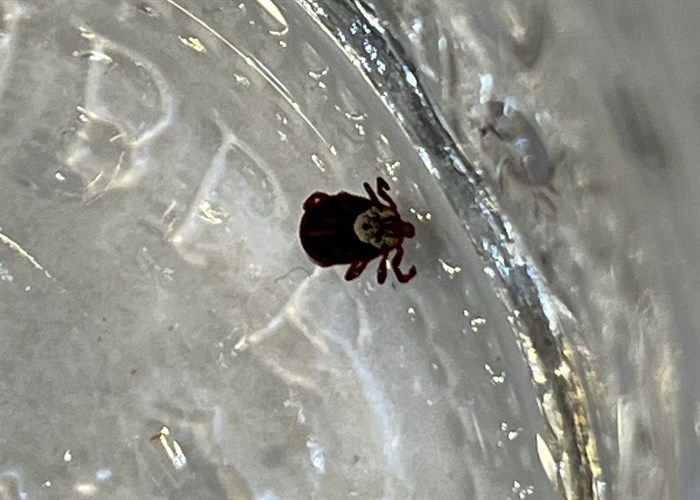
This tick was crawling on a hiker in the Kamloops grasslands.
Image Credit: SUBMITTED/ Wesley Cole
April 12, 2025 - 12:00 PM
It’s tick season in Kamloops and the Okanagan and the critters are climbing up pant legs and burrowing into hairy places in large numbers.
The tiny parasitic arachnids need blood to complete their life cycles and bury their heads under the skin of mammals, birds and reptiles to get it.
They can’t be felt when walking up a body or when they bite, and their flat, tough bodies make them difficult to kill, which is enough to give some people a case of the heebie-jeebies.
“One time we were up in the bush in the Noble Creek area and my daughter said she had a tick,” said Kamloops resident Tanya Rempel-Orsetti. “We ended up pulling 13 out of her hair, and we were so freaked out, but none had embedded themselves.
“I made everyone take off their clothes outside and go shower. I’m curious if they have nests, or how clumps of them get into people like that.”
Last week, Kamloops resident Melisa Mann brought her dog inside from the yard and sat with him on the couch.
“The next thing I knew I had a tick attached to my head,” she said. “It was embedded, so I pinched it and picked it out with my fingers even though you’re not supposed to do that, but I freaked out. I made sure the head was still attached then hit the spot with an antiseptic wash.
"They’re creepy because you can’t feel them, I just felt the tiniest tingle on my head. I didn’t sleep well the first night thinking of it."

A tick crawls in a hikers car in Kamloops.
Image Credit: SUBMITTED/ Wesley Cole
Kamloops resident Tanya Spahman has had two tick experiences in the past.
"One was running wild on my head not yet embedded and one in my springer's ear that I had to twist out with tweezers...so disgusting," she posted on social media. "My girl was also diagnosed with Lyme when she was 11. She had the bullseye circles. Watch for that."
The Southern Interior is home to several species of tick that includes the blacklegged tick, the western blacklegged tick and the Rocky Mountain wood tick.
They live around trees, shrubs, grass, wood piles and piles of leaves and are active when temperatures are consistently above freezing.
Their numbers explode between March and June, and a simple walk through the forest or grasslands can result in numerous little hitchhikers.
Jenna Cass of Kelowna said in a social media post that she's lived in the Okanagan her whole life and has never had a problem with ticks until this year.
Kelowna resident Krista Leigh Potori was hiking in trails at the end of Ballou Park in Glenmore a few days ago.
“I was combing my hair afterwards and noticed a bump at the back of my head,” she said in a message to iNFOnews.ca. “I slowly pulled it out and realized it was a tick, they’re nasty.”

A tick in embedded in a dog at Phases Veterinary Clinic in Kamloops in April, 2024.
Image Credit: SUBMITTED/ Phases Veterinary Clinic
Kamloops Outdoor Club member Wesley Cole pulled 15 ticks off after a hike in the Lac du Bois grasslands earlier this month, while outdoor enthusiast Al Budreau collected over twice that amount in the protected area.
“I’ve never found so many as I got two weeks ago when I was out in the grasslands,” Budreau said. “I was there in the grass for several hours and picked off around 35 ticks afterward.”
He was in the Tranquille area northeast of the city and said it is a notoriously bad spot for ticks. He wears light clothing so the tiny ticks are easier to spot and tucks his socks into his shoes to keep them on the outside, and he always picks them off before getting back into his car.
“Don’t get into the car until you’ve given yourself a darn good check over,” Budreau said. “I take my jacket off, check it inside and pick everybody off. I’ll take my shirt off too, strip to the waist and pick them off.”
Budreau carries a fine-toothed comb to deal with ticks in his hair, adding the pesky bugs won't stop him from enjoying the outdoors.
“I always check after a hike and usually put clothes in a bathtub and check the next day,” Cole said. “They crawl off in the car on the way home from a hike so you can get one days later.”

This tick was found after a hike at Lebanon Creek in Kelowna.
Image Credit: SUBMITTED/ Facebook/ Lynne McCleod
Ticks can become infected if feeding on an infected host, can transmit bacteria, viruses and parasites that can cause Lyme disease, according to a Government of Canada webpage.
You can identify a tick and determine if it a type that can carry diseases by taking a photo and sending it eTick here.
If you have insect stories that give you the heebie-jeebies, send them to news@infonews.ca.
To contact a reporter for this story, email Shannon Ainslie or call 250-819-6089 or email the editor. You can also submit photos, videos or news tips to the newsroom and be entered to win a monthly prize draw.
We welcome your comments and opinions on our stories but play nice. We won't censor or delete comments unless they contain off-topic statements or links, unnecessary vulgarity, false facts, spam or obviously fake profiles. If you have any concerns about what you see in comments, email the editor in the link above. SUBSCRIBE to our awesome newsletter here.
News from © iNFOnews, 2025